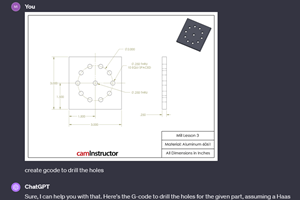Actionable Data Is the Key
"Retrieve, store and analyze" summarizes the main steps a production monitoring system follows to provide actionable data: the information a shop can act on to make better decisions about manufacturing processes.
Share





Shopfloor machine monitoring gives manufacturers a tool to improve processes by providing actionable data regarding the performance of each machine. For instance, if a company is not meeting its goal to produce 10 parts per hour on a certain machine, data monitoring can help identify and resolve issues holding back productivity. Or, if near-zero downtime is an objective, data monitoring software can spot conditions that need attention before a problem occurs.
Data monitoring is employed in many manufacturing environments, from very low-mix automated environments to high-mix automation or standalone machines. It is used regularly in the aerospace industry for producing critical parts, which require a lot of monitoring during the production process. Moldmakers also use data monitoring software in their machining processes due to the extended length of run time.
Likewise, data monitoring software enables manufacturers to stay up to date on machining processes even while they’re away from the shop floor. It is possible to access this data anywhere in the world to track productivity and help a company reap the most from its machine investment.
Data monitoring can be used with standalone machines and with automated systems. Those implementing data monitoring in an automated environment can expect to achieve higher utilization than with manually operated machines. In an automated system, the system can measure and report the productivity for individual machines in the cell. If part throughput should decline in an automated cell, the monitoring data can pinpoint the problem. Or, if the data indicates that all of the machines are experiencing the same low productivity, the operator will know that the cause is external to the automated cell. For example, imbalances in workflow may be causing shortages of material feeding the cell.
With a capable monitoring system, machine data can be organized, analyzed and displayed to greatly improve decision-making on the shop floor. Taking the right actions quickly results in increased productivity, higher quality and greater uptime. Here is a sample of the reports that can be generated by advanced monitoring software:
Multiple machine status. This report shows the state of each monitored machine by displaying “in cycle,” “out of cycle” and other conditions. It gives a list of alarm events and alerts in real time. A recorded history of alarms and alerts can be analyzed later to find trends or patterns.
Machine utilization. This report shows how much time the machine has been running during a specified time period. This helps managers spot possible trouble areas.
Power usage. This report displays how much electrical energy a machine consumes over time. Shops can use this data to schedule energy-intensive machining operations for the particular time of day when fluctuating energy rates are low.
Tool management. This report tracks tool length, diameter, offset and alarm data to help maximize tool life. It also helps the system know what tools are available at each machine and enables manufacturers to replace worn tools before a shortage occurs.
Work scheduling. This report defines a part and the NC programs needed to machine it. The monitoring system scans the programs and then determines if the selected machine has all of the tools required to make that part. The system notifies the operator if any tools are missing.
Spindle monitoring. This report tracks spindle load and other factors related to spindle operation. Any spindle incident occurring in an operation can be traced to the exact point in the program. This helps the operator adjust machining parameters or take other corrective action.
Probe data analysis. This report uses a process capability index such as Cpk to track accuracy in critical features. It diagnoses how well the machine is staying in tolerance and shows if a factor such as tool wear is causing a drift. By recording axial forces, loads and speeds, it can help planners fine-tune processes for faster cutting speeds, greater depth of cut or other improvements.
With machine monitoring software, manufacturers can have more confidence in their operations. The actionable data this software provides can maximize efficiency and minimize downtime. For a deeper discussion of data monitoring, read James Brown's white paper (from Makino), Measure to Improve—Identifying Solutions through Real-Time Production Monitoring, which is available at .
Related Content
4 Commonly Misapplied CNC Features
Misapplication of these important CNC features will result in wasted time, wasted or duplicated effort and/or wasted material.
Read MoreCan AI Replace Programmers? Writers Face a Similar Question
The answer is the same in both cases. Artificial intelligence performs sophisticated tasks, but falls short of delivering on the fullness of what the work entails.
Read MoreSetting Up the Building Blocks for a Digital Factory
Woodward Inc. spent over a year developing an API to connect machines to its digital factory. Caron Engineering’s MiConnect has cut most of this process while also granting the shop greater access to machine information.
Read MoreCan ChatGPT Create Usable G-Code Programs?
Since its debut in late 2022, ChatGPT has been used in many situations, from writing stories to writing code, including G-code. But is it useful to shops? We asked a CAM expert for his thoughts.
Read MoreRead Next
Machine Shop MBA
Making Chips and 91ÊÓƵÍøÕ¾ÎÛ are teaming up for a new podcast series called Machine Shop MBA—designed to help manufacturers measure their success against the industry’s best. Through the lens of the Top Shops benchmarking program, the series explores the KPIs that set high-performing shops apart, from machine utilization and first-pass yield to employee engagement and revenue per employee.
Read MoreAMRs Are Moving Into Manufacturing: 4 Considerations for Implementation
AMRs can provide a flexible, easy-to-use automation platform so long as manufacturers choose a suitable task and prepare their facilities.
Read More

















